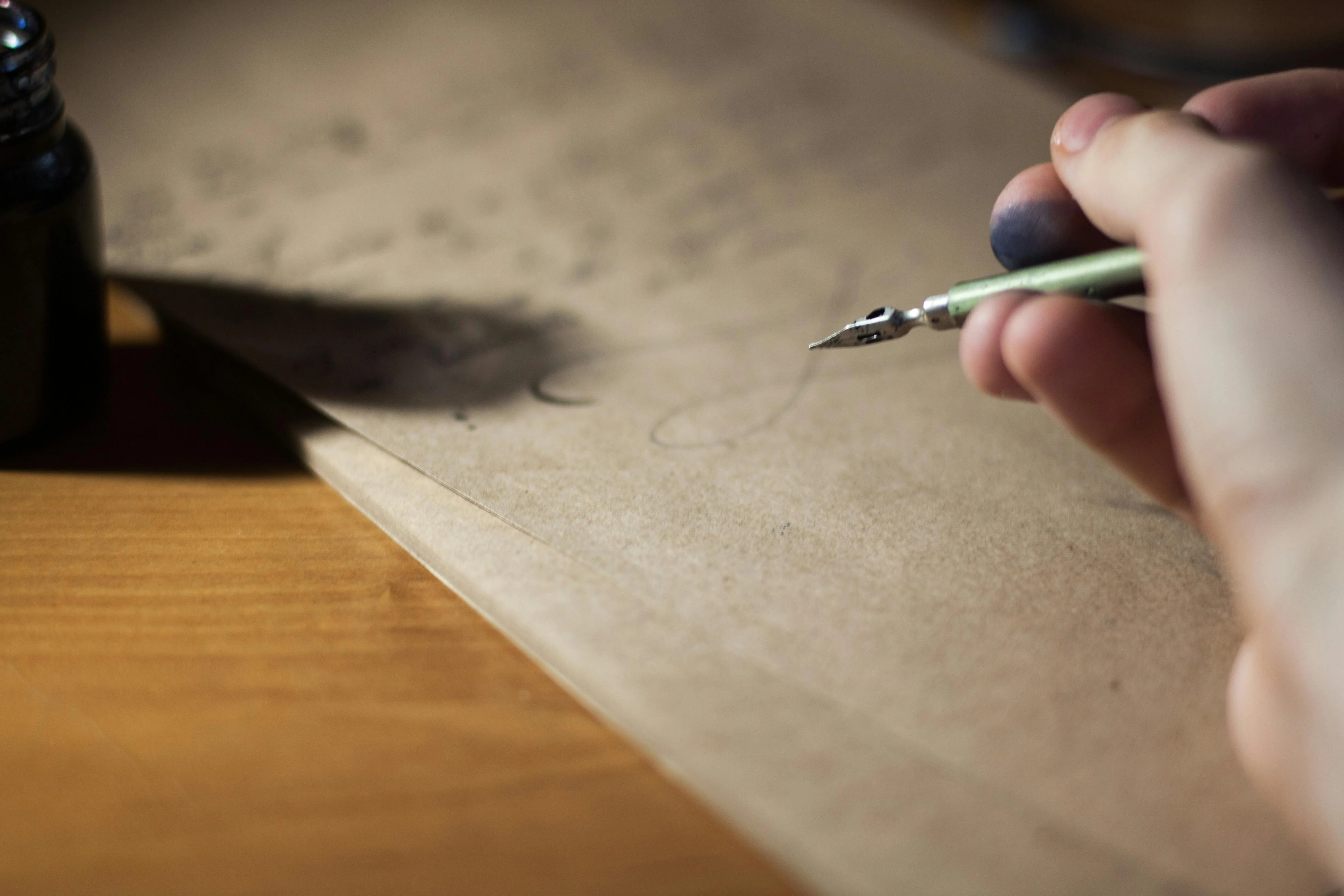Writing in cursive is not only a method of perfecting one's handwriting. It is a skill that will help make your notes look neat and increase your writing speed. This guide will give you a brief overview of the significance of cursive writing.
Cursive Writing and Why It's Important
Handwriting is a basic skill that positively affects students in several ways. It not only aids in learning and memorizing information, but it also allows you to articulate your ideas clearly and creatively. Writing helps you interact with the material more intensively, which may facilitate the process of understanding and remembering.
- Handwritten notes aid in better recall of information.
- Writing can prompt creative thinking.
- Writing serves the role of processing and understanding complex ideas.
So, here is how to write in cursive. Although technology has improved digitally, handwriting skills are still important for students. It is a personal tool for learning, reflection, and also expression. Finding good handwriting is not just about readability but also about having a sense of ownership and making a personal statement.
Cursive Writing: Basic Explanation
Cursive writing is a form of handwriting that refers to the joined letters, making writing faster and more efficient. Cursive letters blend, unlike print writing, in which each letter is distinct. This connection of letters will ensure your writing looks more appealing and advanced.
According to the National Education Association, learning cursive begins by knowing the strokes and practicing them until they become habitual. Then, you learn to link these lines and develop words and sentences from these letters. It is a series of steps that involve patience and practice. Handwriting speed is another major advantage of cursive writing. It can be most helpful in cases such as during exams or when taking notes in class.
Why Does Cursive Writing Hold a Timeless Significance?
Although the digital era has developed, cursive writing is still an eternal symbol for several reasons. Your handwriting is as distinct as your fingerprint, and cursive provides a lovely way to demonstrate this uniqueness. Moreover, cursive acquisition is associated with better motor skills and brain development. In addition to that, cursive writing does not only imply personal or academic gains but is also an art form. Letter and invitation writing in cursive appear more personalized and become more special.
How to Boost Your Cursive Writing Skills
It is training your hand to write perfectly in cursive and understanding the techniques that make it beautiful and effective. Here are some tips to help you pen down cursive easily and gracefully.
Familiarize Yourself with Basic Strokes
The main power of cursive writing lies in polishing the basic strokes: undercurves, overcurves, upstrokes, and downstrokes. These strokes make up the foundation of any cursive letter. Practicing these strokes will help build muscle memory, allowing you to build letters more fluently.
- Undercurves: Start low, push up, and curve over.
- Overcurves: Begin high, curve down and under.
- Upstrokes: Light, upward, thin lines.
- Downstrokes: Downward lines, thicker and firmer.
Once confident with these strokes, you can connect them to form cursive letters. This process prepares the path for more difficult letter shapes and joins, making it easier to move into writing whole words and sentences using cursive.
Start with Lowercase Letters
Lowercase letters are often more basic and monotonous than uppercase letters, which makes them ideal for practicing cursive writing. Start with letters with something common, such as 'a, 'c,' 'd', 'g,' and 'o'. This method assists one to become confident in writing fast. Each time you learn a letter, note where it starts and ends when writing it, for this will be important to help you connect letters later. Work on each letter until you feel comfortable before proceeding to the next one.
Learn Uppercase Letters
Once you have learned the lowercase letters, go to the capital letters. These characters are often more complicated and need a higher understanding of cursive motion. The capital letters in cursive writing are very beautiful and are employed to initiate sentences or proper nouns and, therefore, have an important role in cursive writing.
Practice Letter Connections
The joining of the letters makes cursive writing flow so quickly. No pen or pencil lifting should be done between letters; each letter should flow naturally into the next one. This connection is important as it helps to achieve the distinctive appearance of cursive writing.
For letter linking, begin with letters commonly found together in words. Notice how the final stroke of one letter is the initial stroke of the next. It may require changing how you write certain letters to facilitate smoother connections.
With consistent training in these components – basic strokes, lowercase letters, uppercase letters, and letter connections – you will greatly improve your cursive writing skills. Practice more and more, and one day, cursive writing will become a free-flowing and enjoyable part of your handwriting.
Form Basic Words
When comfortable with the letters and their relationships, move on to simple words. This stage contributes to narrowing down the difference between letter writing and practical cursive writing. Start with short and simple letter combinations such as 'cat,' 'dog,' 'run,' or 'play.' These words will help you to practice connecting various letters in a smooth and fast manner.
Pay attention to keeping the spaces between words and letters the same. This uniformity is important for making the document readable and appealing. As you write, remember how each letter links to the other. Some connections will feel easier, while others may take more work to become competent in. Continue to practice different words so that you can have a holistic improvement in your cursive writing skills.
Advance to Longer Sentences
Begin by learning simple words and then start writing longer sentences. This sequence tests your capacity to keep cursive readability and fluidity throughout prolonged writing. Begin with simple sentences using the words you have been practicing. Then, begin to make the sentences more complicated and lengthier over time.
Do you want to know how to write in cursive? Long sentences increase stamina and enable you to control the movement of your lettering better. It also allows the training of correct word spacing and uniform letter size within a sentence. When you get used to writing longer sentences, you may attempt to write paragraphs, paying attention to the smoothness and fluency of your handwriting. It will help you develop your writing in cursive and improve your writing skills.
Explore Ligatures
Wanna find out how to write in cursive? Ligatures in cursive are specific connections between certain pairs of letters that improve the smoothness and beauty of the writing. Ligatures can help you to improve and enhance your cursive writing. Here is what you should know:
- 'fl' combination: A typical ligature in the latter case is the one in which the 'f' is linked directly to the 'l.'
- 'st' combination: The 's' perfectly joins the 't'; hence, the 'f' and 'l' are often in words such as 'first' and 'last.'
- 'or' combination: A nice shift from 'o' to 'e,' which enriches the word's form.
Ligatures can be different because they depend on the type of cursive you are taught in. Try to apply this information to practice and understand how it can make your writing fast and smooth. Keep in mind that the purpose of using ligatures is not only to make your writing faster but also to give it an individual touch and make it look more sophisticated.
Develop a Consistent Slant
Here is how to write in cursive! A steady slant is vital in cursive writing to ensure the entire written work appears consistent and professional. This uniformity guarantees that your writing reads well and looks consistent on the page. Try to maintain the same angle throughout your letters and words, whether you like a more traditional cursive look with a slant to the right or a rightward slant for a more modern approach.
Besides, here is how to write in cursive even faster! A regular slope makes reading easy and makes your work look professional. The angle that feels most comfortable to you will be found as you practice, and this will be representative of your style of writing. And do not forget to delegate your tasks to our paper writing company if you need more time for practicing.
Experiment with Flourishes
Wanna know how to write in cursive? Flourishes are the ornamental strokes that embellish and give individuality to your cursive writing. After you have mastered the foundation, playing with flourishes will help make your handwriting unique. Begin with simple decorations of a word's first or last letters and then move on to more complex patterns. Uppercase letters, the tails of 'y's and 'g's, or the tops of 't's and 'l's can be decorated with flourishes.
Practice Regularly
Here is another tip on how to write in cursive. The secret of mastering cursive writing lies in practice. Moreover, the consistency in practice aids in the reinforcement of muscle memory, allowing the student to write more fluently and, thus, increase their confidence in their ability to write effectively. Allocate some time each day; writing in cursive can even take a few minutes. You can write letters and diaries or even transcribe paragraphs from books. Besides, you can always pay for essay assignments if you do not have free time!
Cursive Writing Tips
Improving your cursive writing takes attention to a few main points. Here are some tips to boost your writing experience:
- Use the right tools: A high-quality pen or pencil can go a long way.
- Maintain good posture: Find a comfortable position and ensure your hand and wrist are neutral and relaxed.
- Start slow: Pay attention to the form and accuracy, not speed.
- Use lined paper: This ensures uniformity of the width and angle.
If you take notice of these hints, you will discover that cursive handwriting is much simpler and more enjoyable. Practice is the key, so practice a lot, and don't fear mistakes. In the long run, you will have nice and practical cursive handwriting.
Benefits of Learning Cursive Writing
Learning cursive writing can provide several advantages that go beyond better penmanship. It is an ability that can improve one's academic and personal life in numerous aspects. Here is how to write in cursive and benefit from it.
Writing Faster and Better
Here is how to write in cursive and benefit from it! With this type writing, one can write faster without making the content illegible. The linked letters form allows the pen to be lifted more quickly between letters, increasing the writing speed. It is especially advantageous in test-taking situations or when writing in class when time is a factor.
Getting More Creative
Cursive writing can release untapped creativity. When you write in cursive, the flow of the letters activates your brain in a way different from typing or writing in print. Such stimulation can help to enhance creativity in your writing and thinking. Also, by practicing cursive forms and embellishments, you can express yourself, and your handwriting will be original and will convey your personality.
Memory Retention
Research indicates that cursive writing contributes to better memorization. The motor skills required in the physical act of writing in a flowing style are more intricate and may aid learning and recall. When you write your notes in cursive, you are more likely to remember the material than simply typing the notes. Besides, do not hesitate to pay someone to do homework assignments if you feel stressed and deadly tired.





